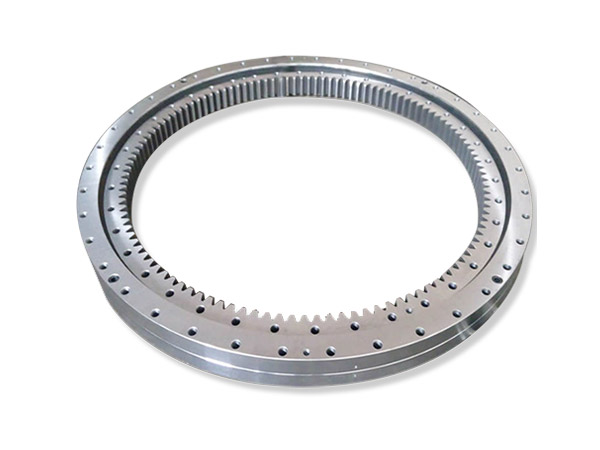¿Cuál es el proceso de fabricación de engranajes de los cojinetes de giro?
El procesamiento de engranajes es un proceso que requiere mucho tiempo en la producción de cojinetes giratorios y también es uno de los principales factores que han restringido la eficiencia de producción de los cojinetes giratorios. Con base en los datos de mecanizado reales, la aplicación de los procesos de fresado y tallado en el procesamiento de los dientes de los rodamientos de la plataforma giratoria se compara a partir de los aspectos de eficiencia y costo, lo que proporciona una base para la selección razonable de tecnología y equipo de procesamiento de dientes de los rodamientos de la plataforma giratoria. Hoy, el editor vendrá a hablar con usted sobre el proceso de fabricación de dientes de los rodamientos giratorios.
1. Selección de material del cojinete de giro en blanco
Generally, 50Mn is used for the slewing bearing ring. After surface quenching, the raceway hardness is HRC55-62. However, sometimes 42CrMo is selected to meet the needs of the host for special applications, which has a higher hardness. LDB’s selection of blank suppliers has undergone strict screening and strictly follows the traceability procedure. For each blank, from receipt to finished product, it can trace the source of the blank according to its serial number, quality inspection and other whole-process data.

2. The technology of making gears from slewing bearings
1. The equipment used in the gear processing department still uses a large number of ordinary gear hobbing machines and gear shaping machines. Although it is convenient to adjust and maintain, the production efficiency is low. If a large capacity is completed, multiple machines are required to produce at the same time. In order to solve the problem of low processing efficiency, while increasing the number of gear hobbing machines and gear shapers, high-speed gear milling machines are used, which has high processing efficiency and good surface finish quality.
2. Some slewing bearings used under severe conditions require surface quenching treatment, such as excavators, pile drivers, wood grabs, graders and other operating conditions, which have relatively large impact loads and require quenching treatment on the tooth surface. The hardness after quenching of several sizes is between 45-60HRC. For common working conditions such as cranes and tower cranes, the tooth surface does not need to be heat treated.
3. With the rapid development of Industry 4.0, slewing bearings are more and more widely used in the automation industry. In this application field, the accuracy requirements for the teeth are relatively high, and the low requirements are also 8 levels of accuracy. In response to the rapid changes in the market, during the construction of the new plant, higher accuracy requirements are required for the equipment to meet the market demand.
4. After the tooth-making process is completed, there are follow-up processes such as fine turning, plane, drilling, track grinding, and assembly, and the slewing bearing can be shipped out of the factory.
3. Introduction to the failure analysis of the slewing bearing gear
1. Improper adjustment of the backlash of the large and small gears during installation, which did not meet the requirements, resulting in poor meshing of the two gears during operation, resulting in broken teeth. The backlash should be adjusted strictly as required.
2. Failure to adjust the meshing gap with the pinion at the maximum position of the gear jump as required, causing the pinion to jam when meshing with the maximum gear jump position during operation, causing tooth breakage. The meshing adjustment should be carried out at the position painted with green paint and the pinion gear should be adjusted according to the requirements for trial operation.
3. Los ejes de los engranajes grandes y pequeños no son paralelos, y los engranajes grandes y pequeños engranan mal después de la instalación, lo que provoca la rotura de los dientes. Debe asegurarse que los ejes de los dos engranajes sean paralelos.
4. Los pernos de montaje no están bien apretados y los engranajes de las mallas grandes y pequeñas no están bien engranados, lo que provoca la rotura de los engranajes. Los pernos deben apretarse según sea necesario.


